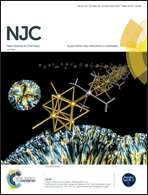The novel sulfonated polyaniline-decorated carbon nanosphere nanocomposites for electrochemical sensing of dopamine
Abstract
Herein, a novel dopamine (DA) electrochemical sensor was developed by combining carbon nanospheres (CNSs) and sulfonated polyaniline (SPANI) with their own excellent characteristics. The sensing materials SPANI/CNSs were prepared through a green and economical approach under hydrothermal treatment, in situ chemical oxidative polymerization, and sulfonation. Scanning electron microscopy and Fourier transform infrared spectroscopy were employed to characterize the morphology and composition of the nanocomposites. Moreover, electrochemical activities of the sensor were investigated by cyclic voltammetry, differential pulse voltammetry, and amperometry. Investigation of the sensor indicated that it had excellent properties towards DA oxidation, with a linear range from 0.50 μM to 1.78 mM, a detection limit of 0.0152 μM (S/N = 3), and a sensitivity of 113.9 μA mM−1 cm−2. Moreover, the sensor exhibited intriguing anti-interference to co-existing substances such as ascorbic acid (AA), uric acid (UA), and glucose (Glu). These electrochemical results could be attributed to the enhanced electron transfer rates and abundant functional groups with negative charges possessed by the nanocomposites. Therefore, the SPANI/CNS nanocomposites showed great application potential for the construction of a DA sensor.



 Please wait while we load your content...
Please wait while we load your content...